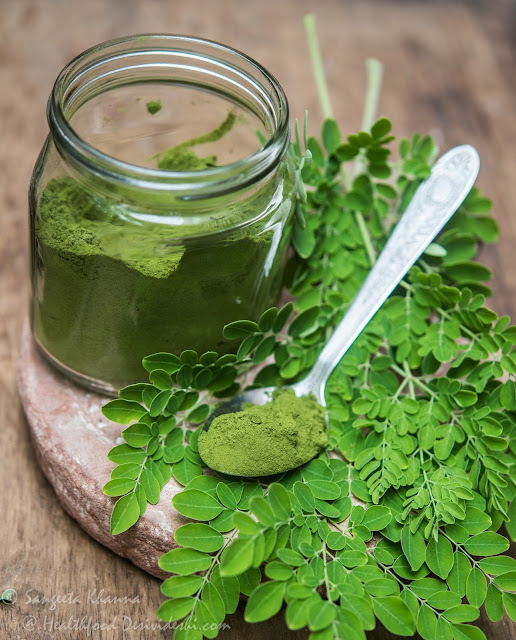how to make drumstick (moringa) leaf powder at home and how to use it
Making Moringa leaf powder at home is quite easy but it
does take some time to sort and clean and then sun dry the leaves before
grinding them in the food processor. Moringa or Drumstick is the wonder
tree that is known for its nourishing properties, every part of the
tree is edible and medicinal.
The
most impressive quality of Moringa being immunity boosting, it was
given to the whole family during every change of season to improve
immunity against chicken pox, the most dreaded viral disease of the
older times. Now Moringa is being exported in several forms to be used
as immunity boosting agent for AIDS patients.
Read more about the benefits of Moringa leaves here.
The
most wonderful thing about Moringa is that it grows all over India and
quite abundantly. The Moringa tree can be propagated easily by seeds or
by stem cuttings during rainy season, it can also be grown in balconies
and terraces for harvesting leaves which are much more nutritious than
the Moringa pods.
I have
shared many Drumstick or Moringa recipes on this blog, many chutneys,
egg scrambles and curries respond really well to the fresh Moringa
leaves. This sponge gourd curry with Moringa powder a recent favourite.
The
advantage of using dry powder of Moringa leaves is that it can be used
instantly and the taste doesn't mask the other ingredients. So you can
keep experimenting with Moringa leaf powder with many recipes and not
feel overwhelmed with one flavour being repeated everyday. I have used
it in my dals, khichdi, parathas, breads, curries, raita, buttermilk,
chutneys, soups and curries.
Some people just dissolve Moringa leaves in
warm water and drink it like a dose of medicine everyday, 1/2 tsp
Moringa powder is good enough for one person.
How to make Moringa powder
Get
fresh tender leaves of Moringa which is preferably the new growth after
the fruiting has ended. This results in a bright colour.
The
mature leaves of Moringa may cause stomach upset in some people so take
care of that and use a very small amount when you use it for the first
time. Practice caution when feeding this to babies.
Get
the leaves plucked along with the stalks, hold all the stalks together
and rinse in a large tub of water at least 3-4 times or till the water
runs clear. Now let the water drain by keeping the leaves in a large
colander, I used my Bamboo sieves that I bring from north-east India
whenever I visit. In about 4-5 hours the leaves get wilted and can be
separated from the stalks easily by holding them together and pulling
downwards. I prefer plucking the leaves in the evening and letting them
wilt overnight after the rinsing.
After
the leaves are separated, spread them in a perforated surface, the
bamboo sieves work wonderfully for this as well. I have a few trays made of steel mesh, the old fashioned colander also work. Remove all
stalks from the leaves so the powder is smooth.
Cover
it with a thin dark cloth and sun dry in strong sun (Indian summer is great
for such things) till the leaves get crisp. In the peak summer it took
just one day to make the leaves crisp but later it took me 2 days. Bring
the leaves indoors in the evening and powder them immediately before
they loose the crispness. This helps to make the powder really fine. I
didn't need sieving the powder but you may sieve it to remove any
fibrous residue.
Transfer
to a clean and dry jar with an air tight lid immediately. The Moringa
powder made this way keeps well for at least 6 months at room
temperature. To prolong the shelf life you can refrigerate it.
Remember you need just 1/2 tsp or 2/3 tsp per person per day if you want to have it everyday.
To
keep the colour as bright as possible, take care to sun dry the leaves
covered but in stronger sun. If the sun is not too bright the colour
becomes a little dull but the medicinal properties are not compromised I am sure, though I
didn't find any studies regarding this.
Note
that some varieties of Moringa have bitter and astringent tasting
leaves. Chose a variety that has sweeter leaves so the Moringa powder
doesn't alter the taste of foods it is added to.
I
added Moringa powder to the poori dough a few times and the result was
great. Add 1.5 tsp Moringa leaf powder per cup of flour to be kneaded
and you get bright colour in your pooris or parathas.
Adding the Moringa leaf powder to pesarettu (green mung dosa) batter also works wonderfully. It can actually be added to any dosa batter.







All your articles are interesting. I want to compliment you for being such an enterprising nature lover and your research on foods Great going
ReplyDelete